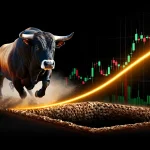
Goldilocks Economy: The Delicate Balance of Prosperity and Peril
Dec 28, 2024
The Enigmatic Goldilocks Economy
In the kaleidoscope of economic terminology, the phrase “Goldilocks Economy” casts a singularly unique light. It originates from the timeless fairy tale Goldilocks and the Three Bears and denotes an economic environment that is neither too hot—triggering inflation, nor too cold—risking recession. Instead, it is just right, a perfect balance resulting in an economic climate conducive to growth, characterized by low inflation and full employment.
This ideal state, however, is not spontaneous. It is typically the outcome of an astute and often overly indulgent Federal Reserve, which deftly controls interest rates to stimulate economic growth or cool down an overheated economy. It’s a financial chess game, with the Fed manoeuvring the pieces to checkmate any threats of boom-and-bust cycles.
The question thus arises: Is the Goldilocks Economy a delicate equilibrium between prosperity and risk? On the surface, it appears to be a period of economic bliss, where businesses thrive, unemployment is low, and inflation is kept at bay. But beneath this veneer of prosperity, there lies a latent peril. The Federal Reserve’s overindulgence in manipulating interest rates can lead to an artificial economic environment, a bubble that could burst with devastating consequences.
The Goldilocks Economy is a tightrope walk. It requires a reasonable and meticulous balance between stimulating growth and curbing inflation. Stray too far one way, and you stir the cauldron of inflation. Veer too much the other way, and you plunge into the icy waters of recession. It’s a delicate balance where prosperity and peril are two sides of the same coin.
The Dance of the Fed and the Goldilocks Economy: A Balancing Act
The Federal Reserve, often seen as the grand conductor of the economic symphony, plays a crucial role in managing the money supply and interest rates to steer the economy through boom and bust cycles. The Fed encourages borrowing, investment, and consumption by reducing interest rates, leading to economic expansion. However, this period of prosperity, known as the ‘boom’ phase, is often followed by a ‘bust’ phase, characterized by economic contraction. This cyclical pattern is a fundamental aspect of economic dynamics.
A historical example of this cycle is the Tulip Mania in 17th-century Holland, where a speculative frenzy drove tulip bulb prices to extraordinary heights, only for the market to collapse dramatically. This illustrates the inherent risks of speculative bubbles. This boom-and-bust cycle is not just a relic of history but a recurring theme in modern economies.
The Federal Reserve’s challenge is akin to a delicate dance, requiring skill and precision to manage economic growth without triggering inflation or asset bubbles. This balancing act is vividly illustrated by the concept of the Goldilocks Economy, where the central bank must foster growth while keeping inflation in check. If the Fed raises interest rates too quickly to combat inflation, it risks plunging the economy into recession. Conversely, if it is too lenient, it may fuel asset bubbles that could lead to severe economic downturns when they burst.
A notable instance of this dilemma occurred during the stagflation of the 1970s in the United States. The Federal Reserve faced the dual challenge of high inflation and stagnant economic growth, which defied conventional economic strategies. Policymakers had to navigate a tightrope, balancing the need to control inflation without stifling economic activity.
Experts highlight that the Fed’s task is further complicated by the lag in monetary policy effects, which can take 12 to 18 months to manifest fully in the economy. This delay means that the Fed must anticipate future economic conditions and act preemptively, often based on incomplete data. The Fed employs various tools to manage these challenges effectively, including interest rate adjustments, quantitative tightening, and forward guidance.
The Mass Psychology of the Market
Understanding this cycle requires understanding economics, mass Psychology, and contrarian thinking. The market, in essence, reflects the collective mindset of its participants. During a boom, the crowd’s exuberance can inflate asset prices beyond their intrinsic value, creating a bubble. Conversely, in a bust, the crowd’s fear can push prices below their true worth, creating a buying opportunity for contrarian investors.
This herd mentality is evident in the Dot-com Bubble of the late 90s, where investor euphoria propelled internet stocks to astronomical heights before they crashed spectacularly. The aftermath left a trail of financial carnage and offered buying opportunities to those who dared to go against the crowd.
The Technical Approach to Market Timing
Like captains steering their ships through the vast sea of financial markets, investors can harness the power of technical analysis to identify potential investment opportunities. Technical indicators like the Moving Average Convergence Divergence (MACD), Relative Strength Index (RSI), and Stochastics serve as navigational tools, signalling when an asset may be overbought or oversold. When interpreted correctly, these indicators can provide insights into potential market reversals, like a lighthouse guiding seafarers through tumultuous waters.
Take, for instance, the stormy seas of the 2008 Financial Crisis. These technical indicators would have painted a picture of an oversold market during this period. This would have been a signal to investors, a beacon in the darkness, suggesting a lucrative buying opportunity just before the market rebounded in 2009.
The Perils of a Goldilocks Economy
Despite its enchanting allure, a Goldilocks Economy often teeters on the edge of a precipice. It is frequently fostered by an accommodating Federal Reserve, whose deft manipulation of interest rates can inadvertently inflate asset bubbles. Underneath this ideal economic state’s golden glow lurks a potential inferno. When these bubbles burst, the economy can contract sharply or, in a worst-case scenario, spiral into a recession.
This chilling reality was starkly evident in the 2007 Housing Bubble. During this period, low interest rates birthed a climate of reckless lending and soaring housing prices, inflating a bubble of false prosperity. When this bubble inevitably burst, it triggered a financial tsunami that swept the globe, causing widespread economic devastation. This catastrophic event served as a stark reminder of the brutal potential of a Goldilocks Economy, revealing the shadow side of prosperity.
A Goldilocks Economy is akin to a beautiful, yet potentially dangerous, beast. It is an ideal economic state – a perfect blend of low inflation, full employment, and steady growth. However, beneath this gleaming facade, there exists a potential danger. The same accommodating policies that nurture this economic state can also fuel asset bubbles, and when these bubbles burst, the golden economy can quickly become a nightmare. This dual nature of a Goldilocks Economy is a cautionary tale, reminding us of the perils that lurk beneath the surface of prosperity.
Investing in a Goldilocks Economy requires the strategic foresight of a chess player. It’s about anticipating the Fed’s moves, understanding market psychology, and using technical indicators to time the market. Like a game of chess, it’s about thinking several moves ahead and positioning oneself strategically.
The Role of Investor Education in a Goldilocks Economy
In the stormy seas of a Goldilocks Economy, investor education emerges as the steadfast compass, guiding investors through the unpredictable waves. By understanding the economic cycle, the whims of crowd psychology, and the role of technical analysis tools, investors are better equipped to make informed decisions, safeguard their investments from potential pitfalls, and harness opportunities to maximize returns.
The Great Recession of 2008 is a stark illustration of the importance of investor education. This tumultuous period was a brutal wake-up call for many investors who were blindsided by the bursting of the housing bubble and the subsequent market crash. However, those armed with a solid understanding of economic fundamentals and the intricacies of the boom-bust cycle were better prepared to navigate the storm. They could weather the financial turmoil and adeptly seize the opportunity presented by the following market correction.
Investor education is the lighthouse in the stormy seas of a Goldilocks Economy. It enables investors to understand the underlying forces that drive the market, the implications of the Federal Reserve’s policies, and the signals that technical analysis tools provide. It is the shield that protects them from potential risks and the sword that allows them to seize opportunities. In the delicate balance of a Goldilocks Economy, investor education is the key to unlocking informed, strategic decisions that weather economic storms and harness the winds of prosperity.
Conclusion: The Goldilocks Economy and You
Navigating a Goldilocks Economy might appear daunting. Yet, even this labyrinth can be navigated with an understanding of the boom-bust cycle, the principles of mass psychology, contrarian investing, and technical analysis. The question is no longer “Goldilocks Economy – a delicate balance of prosperity and peril?” but “How do I balance prosperity and peril in a Goldilocks Economy?” The answer lies in your hands.
In a Goldilocks Economy, where conditions are “just right” for growth without overheating, the balance is delicate and often temporary. Understanding the cyclical nature of economic expansion and contraction is crucial. As companies grow and generate positive earnings, stocks perform well, but this period of stability is often followed by a bust cycle.
To thrive in such an environment, one must adopt a strategic approach. Mass psychology helps understand market sentiment, while contrarian investing allows you to capitalize on market overreactions. Technical analysis provides the tools to identify entry and exit points, ensuring you can make informed decisions.
Moreover, the principles of living below your means and investing the savings can provide a buffer against economic volatility. As Warren Buffett and Charlie Munger have demonstrated, patience and long-term thinking are vital to building wealth. By saving and investing wisely, you can protect yourself against the eroding effects of inflation and ensure financial stability.
In conclusion, the Goldilocks Economy presents both opportunities and challenges. You can navigate this economic landscape successfully by leveraging the right strategies and maintaining a disciplined approach. The balance of prosperity and peril is within your control, and with the proper knowledge and tools, you can achieve financial security in any economic climate.










